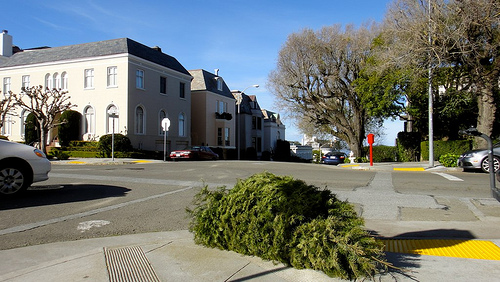In Defense of the Christmas Tree Tax that Isn't a Tax at All
Millions of Christmas trees will be hauled away this week — some will enjoy a useful life after death and many others will end up in the dumps. But record numbers of Christmas trees will also be boxed up and stored in closets till next year. And that has many Christmas tree growers feeling in the dumps, ever more so after anti-tax crusaders trashed a plan to rescue their declining industry by labeling it “Obama’s Christmas Tree Tax.”
The $0.15 fee on the sale of fresh Christmas trees hardly seems like the stuff of political scandal. But announced in November—just days before many Americans would make the trip to tree farms in search of the perfect tree—and branded by conservatives as an assault on Christmas and a sign of government overreach, the story quickly gained traction, with the Drudge Report driving nearly a million visitors to the Heritage Foundation, which broke the story. Before long, mainstream news outlets were reporting that the administration had caved to conservative backlash and decided to delay the “Christmas tree tax” indefinitely.
Regrettably, while the Heritage Foundation is taking a victory lap, many agricultural economists are shaking their heads. They know that, far from a conventional tax, the proposed tree fee would be one among dozens of similar programs grounded in economics and shown through numerous studies to bolster domestic farmers’ incomes. Several such campaigns have entered the pop culture lexicon with phrases that are instantly familiar to consumers, like “Got Milk,” “Beef. It’s What’s for Dinner,” “Pork, the Other White Meat,” and “Happy Cows Come from California.”
All of these programs are voted in by the respective growers, themselves — often a supermajority of them, in fact — and funded by assessments on themselves. The programs are also subject to periodic renewal by these same growers, and are almost always voted back into effect with overwhelming support.
Despite sunny assurances from the Heritage Foundation that “the American Christmas Tree has a great image that doesn’t need any help from the government,” Christmas tree growers have been losing market share in recent years to factories in China that mass-produce trees made of metal and plastic. The L.A. Times reported during the week of Christmas that the domestic live-tree industry has “declined sharply” as “wrenching changes have reshaped the $1.5-billion-a-year industry.” Artificial tree sales have doubled to 17.4 million from 2003 to 2007. It was precisely this problem that the Christmas Tree Marketing Board was supposed to fix, supported by about $2 million in revenue from the tree fee.
Agricultural commodity marketing boards are designed to resolve market failures that result in farm commodities being under-promoted relative to products from other more highly concentrated sectors of the economy wherein firms can appreciably affect demand for their products with individual promotional efforts. Generic commodity marketing suffers from a classic free rider problem. An individual Christmas tree grower could reap benefits from his investment in promoting live Christmas trees only in proportion to his market share, which, is naturally near zero for most of the family operations. Other growers would also reap the benefits of his investment according to their market shares and yet incur none of the costs. Why, then, would any grower undertake marketing on his own?
Heritage notes that, in the past, voluntary Christmas tree marketing programs collapsed after three years, as increasing numbers of growers declined to make contributions and funds dried up. But whereas Heritage suggests past failures as a reason to oppose the new fee, they, in fact, highlight the perniciousness of the free rider problem and the need for compulsory grower support to ensure success. And don’t forget, the Christmas tree fee only survives if it garners support from a majority of Christmas tree growers.
The question now is whether mom-and-pop Christmas tree operations will survive the threat imposed by imported, fabricated imposters that, while short on tradition and ceremony, offer convenience: no tree sap, no pine needles, and no saws. Virtually every grower-approved check-off, as the fees are called, has been approved by the USDA, which administers the programs but has never in recent history deviated from default approval because of political exigencies. And though the check-offs have been challenged in court as a form of compulsory speech, the U.S. Supreme Court has affirmed their constitutionality, even its conservative members.
Heritage is right about one thing, though. As with a tax, a portion of the grower-assessed fee, which equates to roughly 0.4% of the price of a typical tree, will be passed on to consumers according to the price responsiveness of Christmas tree demand. But that is about where the similarities end. Unlike a tax, the fee won’t raise a dime for Uncle Sam.
One can imagine an intelligent debate on the merits of commodity check-offs, in general, and the Christmas tree one, in particular. But after the alarmist rhetoric from the anti-tax right, we are, regrettably, left only to imagine.


Comments